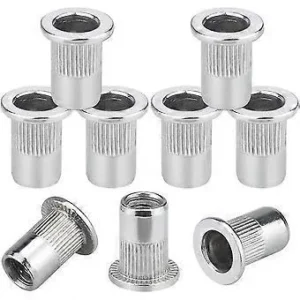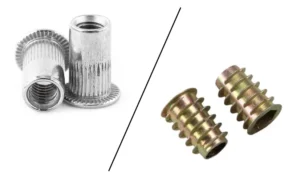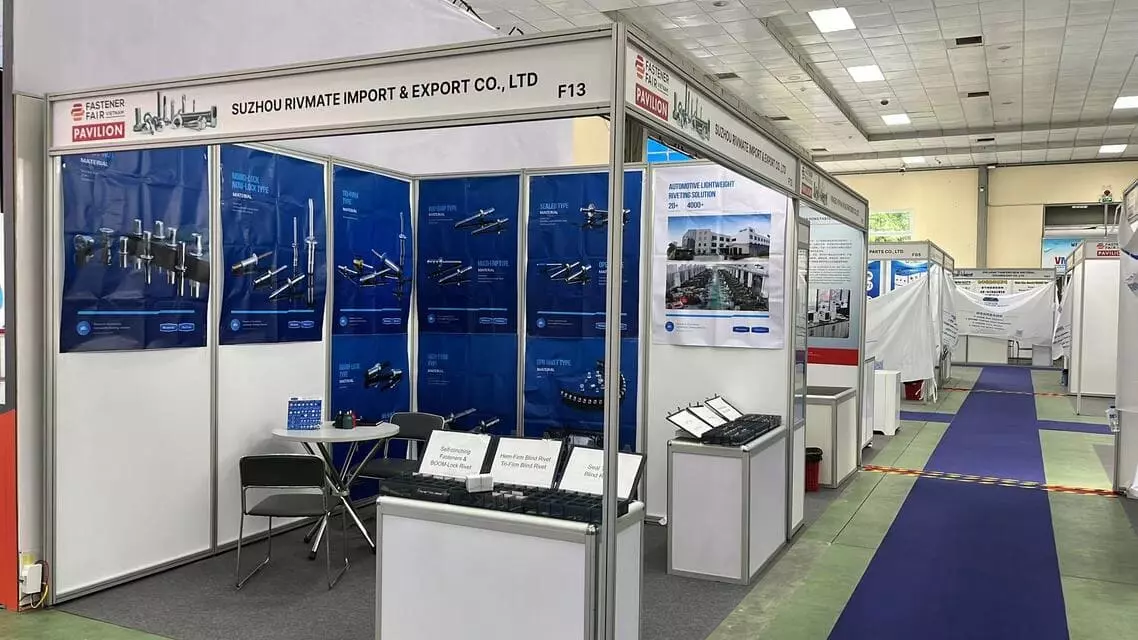Everything You Need to Know About Closed End Rivet Nut
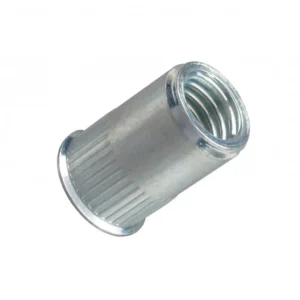
Leading Rivet Nut Manufacturer and Supplier in China

Closed end rivet nuts are more than just threaded fasteners—they’re a reliable solution for applications requiring sealing, electrical isolation, and enhanced structural protection. Unlike open end rivet nuts, their sealed design prevents bolt over-penetration, blocks contaminants, and ensures greater safety in tight or sensitive assemblies. In this guide, we’ll explore the key benefits, typical applications, material and coating options, and installation considerations to help you determine when and why to choose closed end rivet nuts for your project.
Table of Contents
What Is a Closed End Rivet Nut?

A closed end rivet nut is a hollow metal fastener with internal threads, characterized by a completely sealed bottom. It is installed by deforming its body using a special tool, allowing it to be securely fastened to thin sheets, tubing, or other workpieces accessible from only one side. Compared to open-end rivet nuts, the closed-end version offers superior sealing performance and protective capabilities due to its unique structure.
Closed End vs. Open End Rivet Nuts – Key Differences
| Feature | Open End Rivet Nut | Closed End Rivet Nut |
| Tail Design | Open bottom | Completely sealed bottom |
| After Installation | Screw can pass through | Screw cannot penetrate the bottom |
| Sealing Capability | Cannot prevent fluid or dust ingress | Effectively blocks liquids, gases, and contaminants |
| Electrical/Spatial Protection | Risk of contact | Prevents screw from touching circuits or internal components |
The sealed tail of a closed end rivet nut prevents the intrusion of liquids, oil, pressure leakage, or foreign particles into the threaded cavity, making it ideal for waterproof, corrosion-resistant, and short-circuit-proof applications. It is widely used in electronics, electrical equipment, automotive, rail transit, and sealed enclosure systems.
Common Head and Body Styles
Closed end rivet nuts are available in various head and shank combinations to suit different installation scenarios:
a. Common Head Styles
- Flat Head
- Slightly protrudes above the base material after installation, offering a wide load-bearing surface. Ideal for general structural applications.
- Countersunk Head
- Features a tapered design to fit into chamfered holes, allowing for a flush finish with the material surface. Enhances aesthetics and safety.
- Reduced Head
- Has a smaller diameter, suitable for tight installation spaces or where visual appearance is not a priority.
b. Common Body Styles
- Round Body
- Easy to install and suited for applications with low anti-rotation requirements, especially in metal or plastic sheets.
- Knurled Round Body
- Features knurled surface texture to increase friction with the base material and prevent spinning during installation or use.
- Hex Body
- Requires a hexagonal installation hole. Offers excellent anti-rotation performance, ideal for high-torque applications.
How Does a Closed End Rivet Nut Work Structurally?
Function of the Sealed Bottom Design
The most distinctive feature of a closed end rivet nut is its completely sealed bottom. This design effectively prevents dust, moisture, and other liquids from entering the base material through the bolt end. It significantly enhances the overall sealing performance, protects the connection point from corrosion, and shields internal components from environmental damage. This makes it especially suitable for applications requiring waterproofing, dust resistance, and corrosion protection.
Riveting Working Principle
The installation process of a closed end rivet nut is similar to that of an open end type. A rivet tool applies force to deform the nut’s body. Specifically, when the rivet tool pulls, the deformation section at the tail end of the rivet nut expands or folds back behind the base material, creating a strong clamping force. This ensures the rivet nut is firmly anchored. Moreover, the sealed end prevents the bolt from pushing through the nut, eliminating potential risks related to bolt overextension.
In summary, the closed end rivet nut combines a sealed structure for enhanced protection with a proven deformation-based riveting mechanism to deliver reliable mechanical fastening.
What Are the Key Advantages of Closed End Rivet Nuts?

a. Excellent Resistance to Liquid and Gas Penetration
Closed end rivet nuts feature a fully sealed bottom, meaning there is no hole at the base of the nut. This design effectively blocks the passage of various liquids (such as water, oil, and chemical solvents) and gases (including moisture, dust, and corrosive fumes) through the rivet nut into the internal structure.
This significantly enhances the sealing performance of the equipment, preventing moisture intrusion and reducing the risk of corrosion.
It is especially beneficial for outdoor equipment, marine applications, automotive chassis, and other environments exposed to high humidity or corrosive conditions.
When combined with corrosion-resistant coatings (such as zinc plating or Dacromet) or stainless steel materials, it provides dual protection and extends the service life of the joint.
b. Prevents Bolt Over-Extension and Equipment Interference
When bolts are inserted into fasteners, excessive length can lead to them protruding beyond the nut, potentially colliding with internal components in compact devices and causing damage.
The sealed bottom of a closed end rivet nut acts as a physical barrier, limiting the maximum bolt penetration depth and preventing mechanical interference or safety hazards from overly long bolts.
This is particularly important in space-constrained designs for electronic devices, enclosures, instrumentation, and control panels, where reliability and safety are paramount.
c. Ideal for Electrical Insulation, Dustproofing, and Waterproofing
Electronic and electrical equipment often require high levels of insulation and environmental protection. Thanks to its sealed bottom, a closed end rivet nut:
Prevents screws from penetrating and making contact with internal circuitry, thereby reducing the risk of short circuits or electrical leakage.
Effectively blocks dust, moisture, and liquids from entering sealed enclosures, enhancing the device’s ingress protection rating (such as IP65 and above).
It is widely used in household appliances, communication devices, automation cabinets, and outdoor instruments, ensuring long-term reliable operation.
d. Enhanced Product Appearance and Safety
- The closed bottom design improves the visual appearance of the installed product by eliminating protrusions and ensuring a clean, flush finish.
- It eliminates the risk of exposed sharp bolt ends, reducing the chance of accidental scratches during handling and improving user safety.
- When combined with anti-rotation features (such as hex shank, knurled or toothed body), closed end rivet nuts also provide superior resistance to loosening from vibration, ensuring long-lasting, secure fastening.
What Makes Closed End Rivet Nuts So Effective at Sealing?

Closed End Rivet Nuts are widely recognized for their exceptional sealing capabilities, making them a key solution for demanding environments where waterproofing, dustproofing, corrosion resistance, and leak prevention are critical. Below is a detailed explanation from four perspectives: structural principle, real-world performance, material combinations, and engineering benefits.
1. Structural Principle: Sealed Bottom for Isolation
The closed end rivet nut features a fully enclosed bottom with no through-hole, unlike standard open-end types. This closed tail design blocks any path for fluids, gases, or debris from penetrating through the bolt connection.
When a bolt is inserted, its threaded section forms a tight fit within the internal threads, while the sealed base completely prevents physical contact between the external environment and the internal cavity.
Once installed, the fastener’s rear forms a natural barrier, ensuring that even in high-pressure, high-humidity, or dusty environments, no seepage occurs from the rear end.
2. Real-World Sealing Performance
Closed end rivet nuts excel in sealing applications across a variety of use cases:
Marine Equipment and Ship Structures: Exposed to saltwater and humid climates, traditional nuts are prone to corrosion and leakage. The sealed design effectively blocks moisture intrusion into housings and junction boxes.
Battery Packs and EV Chassis: Prevents muddy water or corrosive fluids from road surfaces from entering the battery pack through bolt paths, enhancing the safety of the vehicle’s electrical system.
Electrical Control Panels, Outdoor Surveillance Systems, and PV Junction Boxes: When paired with sealing washers, the closed design can elevate overall protection ratings to IP65, IP67, or even IP68.
Hydraulic and Pneumatic Mounting Systems: Prevents pressure instability caused by fluid leaks or reverse flow through fastener points.
3. Materials and Corrosion-Resistant Finishes Enhance Sealing
Closed end rivet nuts are typically made with materials and coatings that complement their sealing function:
Stainless Steel (304, 316): Excellent corrosion resistance, ideal for marine or acidic/alkaline environments.
Aluminum Alloy Closed End Nuts: Lightweight and moderately corrosion-resistant, suitable for weight-sensitive protective applications.
Dacromet or Zinc-Nickel Coatings: Applied to carbon steel nuts, these finishes can withstand salt spray testing of 500–1000+ hours, dramatically improving service life in outdoor settings.
This combination of sealed structure + corrosion-resistant materials + protective coatings forms a comprehensive defense system.
4. Engineering Value of Sealing Performance
In practical engineering applications, the sealing capability of closed end rivet nuts contributes to more than just the integrity of a single fastening point. It delivers broad system-level advantages:
Extends Equipment Lifespan: Prevents internal corrosion or short circuits due to moisture ingress.
Improves Maintenance Efficiency: Reduces the need for post-installation service caused by leaks or failure at fastening points.
Meets High-Standard Sealing Certifications: Helps achieve CE, UL, IP, or other industrial/export certifications.
Enhances User Experience and Safety: Especially vital in high-stakes industries such as high-pressure systems, rail transit, and aerospace, where closed-end rivet nuts are often considered standard.
Conclusion:
Sealing performance is not just a functional feature of closed end rivet nuts—it is the core advantage that makes them indispensable in high-standard, high-risk applications. When paired with the right material and installation method, they become a critical component in industrial-grade sealing solutions.
How Do Closed End Rivet Nuts Provide Enhanced Protection?
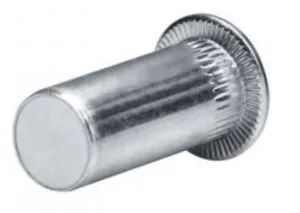
The protective capability of Closed End Rivet Nuts lies in their sealed-end structure, offering electrical isolation, safe assembly, and spatial control. In electronics, electrical systems, precision instruments, and space-constrained assemblies, they serve not only as fasteners but also as protective barriers. Below is a detailed analysis of their protective role from two key perspectives:
1. Electrical Protection: Preventing Bolt Penetration to Safeguard Circuits
In many electronic and electrical systems, internal components such as circuit boards, wires, and connectors are densely arranged and require strict insulation distances and contact safety. If using standard open-end rivet nuts, bolts may protrude through the rear, and during fastening, may accidentally touch internal conductive components, leading to:
Short circuit risks: Bolt ends contacting live wires, bus bars, or PCB traces can trigger immediate shorts;
Electrical breakdown: In high-voltage applications, compromised insulation distances may result in dielectric breakdown and arcing;
Signal interference: Contact with signal or grounding lines may disrupt normal device function.
With Closed End Rivet Nuts, the completely sealed bottom physically blocks bolt travel. Even if overtightened, the bolt cannot penetrate the rear and reach internal components, thus:
Maintaining sufficient insulation clearance;
Ensuring the stability and safety of the electrical system;
Meeting high-level electrical safety standards such as UL, IEC, and RoHS.
2. Structural Protection: Preventing Bolt Interference and Improving Assembly Safety
In tight or component-dense mechanical assemblies such as battery modules, control cabinets, medical devices, and railway electronics, bolt over-penetration can result in:
Contact with rear enclosures or parts, causing poor assembly fit;
Collision with internal wiring, tubes, or cables, leading to potential damage;
Loosening due to uneven installation pressure, reducing connection reliability.
The sealed end of the Closed End Rivet Nut effectively limits bolt travel distance, offering the following protection:
Physical anti-collision: Prevents bolt ends from striking rear components or structures;
Installation stop-limit: Acts as a natural stop for bolt length within design tolerance, avoiding over-tightening;
Standardization for fastener control: Facilitates uniform use of standard bolt lengths, improving consistency in mass assembly;
Space efficiency: Eliminates the need for rear space behind the nut, ideal for thin or flat product designs.
3. Overall Protection Value
The protection provided by Closed End Rivet Nuts extends beyond individual fasteners to system-level risk control:
Enhances electrical safety redundancy in precision electronics;
Optimizes space utilization and structural compactness in modular assemblies;
Enables complete isolation at connection points in high-voltage, high-frequency, or sensitive environments;
Meets the stringent design requirements of industrial equipment, compact electronics, and aerospace systems where “zero error, zero interference” is essential.
Conclusion:
The protective role of Closed End Rivet Nuts is far more than simply “sealing a hole”—it creates an invisible shield that ensures safe operation and structural integrity in critical applications. Engineers no longer need to worry about bolts “going in too far” or “touching the wrong things.” In compact, high-precision modern designs, these nuts offer an irreplaceable system-level solution.
Where Are Closed End Rivet Nuts Commonly Used?
Closed End Rivet Nuts are widely used across various industries and equipment types due to their excellent sealing and protective properties. They are especially suitable for applications that demand high levels of sealing, dust and water resistance, and safety. Below are several typical industries and specific application examples:
Automotive Industry
Body structure components: Closed end rivet nuts are used in body panels and chassis connections to prevent moisture and dust from entering, thereby avoiding corrosion and component damage.
Battery packs and electronic control modules: Ensure a sealed internal environment for battery enclosures and electronic modules, protecting against moisture and contaminants to enhance safety and durability.
Chassis component fastening: Prevent bolts from protruding into vehicle clearance space or damaging other components.
Electrical Equipment Industry
Junction boxes and control cabinets: Closed end rivet nuts effectively block dust and moisture from entering enclosed spaces, ensuring stable electrical connections and insulation safety, and preventing short circuits or failures.
Industrial automation equipment: Maintain equipment sealing in high-humidity or corrosive gas environments, prolonging operational life.
Medical and Military Equipment
Medical device enclosures: The closed-end design prevents liquid intrusion into sensitive electronic components, ensuring long-term stable operation and patient safety.
Military equipment: Adapt to harsh outdoor conditions by preventing dust and moisture ingress, enhancing the reliability and durability of the equipment.
Waterproof Electronics
- Outdoor surveillance systems, telecom base station enclosures: When used with sealing washers, closed end rivet nuts effectively prevent rainwater and dust from entering, ensuring proper equipment operation.
- Portable electronic device housings: Improve overall product protection ratings and enhance user experience.
What Are the Material and Surface Finish Options for Closed End Rivet Nuts?
Closed end rivet nuts are subject to strict material and surface treatment requirements depending on the application, as these factors directly impact their corrosion resistance, mechanical strength, and service life. Below is a detailed overview of commonly used materials and coating processes:
Common Materials
Carbon Steel
Advantages: High strength, low cost, good machinability.
Disadvantages: Prone to rust if left uncoated; relies heavily on surface treatments for corrosion protection.
Typical Applications: Industrial equipment, internal automotive structures, electrical control panels in moderate corrosion environments.
Stainless Steel (304 / 316)
Advantages: Naturally corrosion-resistant, strong anti-rust properties, ideal for humid or highly corrosive environments.
Type 304: General-purpose stainless steel used in food equipment and outdoor installations.
Type 316: Contains molybdenum for enhanced resistance to chloride corrosion; suited for marine and chemical environments.
Disadvantages: Higher cost and more difficult to machine.
Typical Applications: Outdoor equipment, medical devices, military equipment, marine structures.
Aluminum
Advantages: Lightweight, rust-resistant, suitable for lightweight structures and soft materials.
Disadvantages: Lower strength, not ideal for high-load connections.
Typical Applications: Electronic enclosures, aerospace interior components, lightweight assemblies.
Common Surface Finishes
Zinc Plating
A layer of zinc is applied to provide basic corrosion resistance.
Available in finishes like yellow zinc and clear zinc; commonly used for indoor applications.
Nickel Plating
Enhances oxidation resistance and aesthetic appearance.
Improves wear resistance; suitable for components requiring a refined look in light industrial use.
Dacromet Coating
An eco-friendly, non-electroplated anti-corrosion coating suitable for harsh environments.
Offers salt spray resistance exceeding 500 hours; widely used in automotive chassis applications.
Black Oxide
Provides basic rust protection with a uniform dark appearance.
Best for non-exposed environments or for aesthetic matching with black components.
Impact of Material and Surface Finish on Corrosion Resistance
| Material | Surface Finish | Corrosion Resistance (Relative) | Typical Applications |
| Carbon Steel | Zinc Plated | ★★☆☆☆ | Indoor equipment, control cabinets |
| Carbon Steel | Dacromet | ★★★★☆ | Automotive chassis, outdoor brackets |
| Stainless Steel 304 | Untreated (or Passivated) | ★★★★☆ | Electrical enclosures, construction hardware |
| Stainless Steel 316 | Untreated | ★★★★★ | Marine equipment, medical structures |
| Aluminum | Anodized | ★★★☆☆ | Lightweight brackets, electronic devices |
Note: Corrosion resistance ratings are for reference only. Actual performance depends on environmental factors such as humidity, salt spray concentration, and temperature.
Closed End vs Open End Rivet Nuts: Are There Any Differences in Installation?
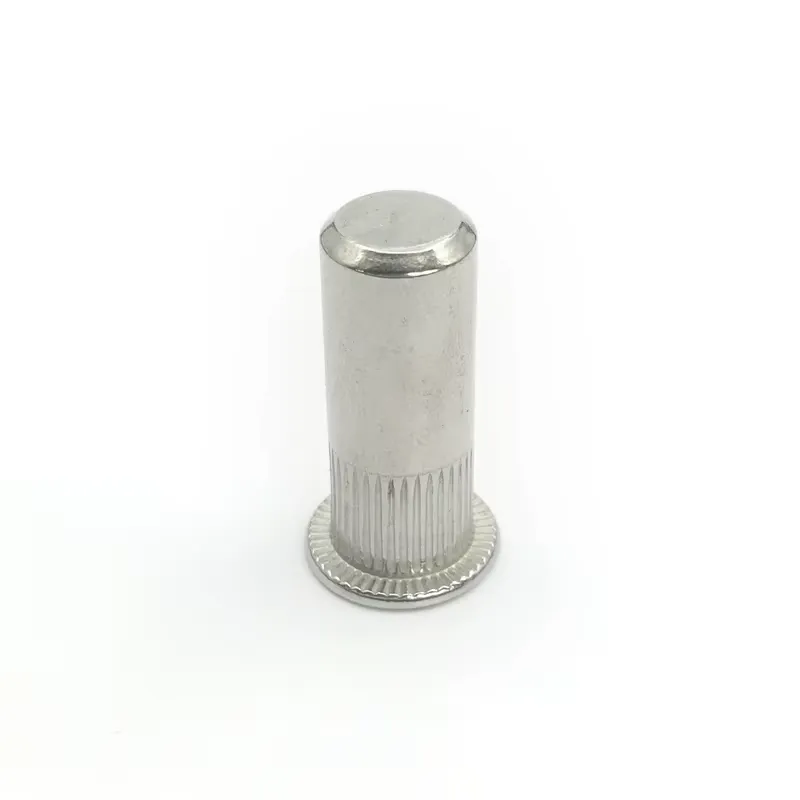
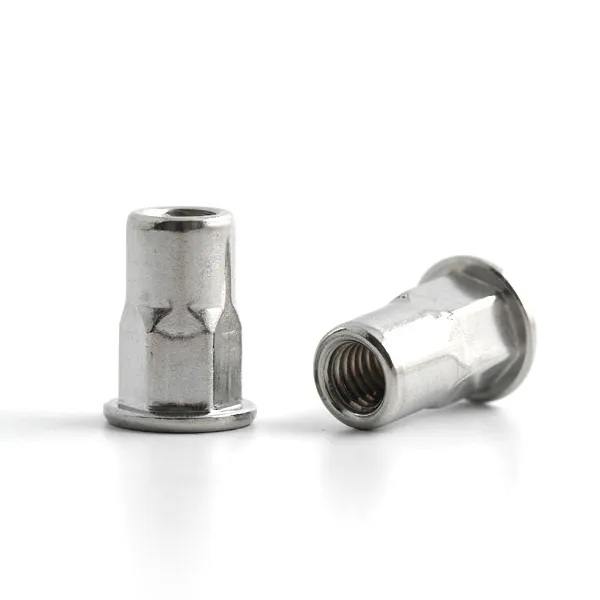
Closed end and open end rivet nuts share the same basic installation principle—both rely on the plastic deformation of the rivet nut’s rear section during installation to secure it firmly to the backside of the workpiece. However, due to the unique closed-end structure, there are several key considerations to keep in mind during actual installation:
Closed end limits bolt travel: In closed end rivet nuts, the bolt cannot pass through the back of the nut. Therefore, bolt length must be selected carefully to avoid insufficient clamping or internal interference.
Sealed bottom is more prone to stress concentration: The solid end may experience localized stress and indentation, especially under excessive force or repeated installation. Over-tightening should be avoided.
Watch for air or liquid entrapment: In enclosed cavities, air or fluid may become trapped when using closed end rivet nuts. Venting must be considered to avoid structural issues or poor installation quality.
Use torque-limited tools: It is recommended to use installation tools with torque control to prevent damaging the closed end due to excessive pulling force.
While the installation method is generally the same, closed end rivet nuts require more attention in bolt selection, force control, and sealing considerations.
Installation Tools and Tips for Closed End Rivet Nuts
Closed end rivet nuts can be installed using various tools. To ensure the sealed end remains intact and the overall quality is preserved, the following tools and best practices are recommended:
Recommended Installation Tools
Hand Rivet Nut Tools (suitable for low-volume operations):
Example: General-purpose M6–M10 hand rivet nut tools.
Pneumatic or Electric Rivet Nut Guns (ideal for batch production):
Prefer models with torque control settings from industrial brands like AVK, GESIPA, etc.
Installation Steps
Drill a Hole:
Drill according to the outer diameter of the rivet nut; the hole size must be precise to avoid loose fit or excessive interference.
Clean and Chamfer the Hole (if required):
For countersunk closed end rivet nuts, chamfering may be needed (commonly at 90° or 120°).
Load the Rivet Nut onto the Tool:
Screw the rivet nut onto the mandrel or nosepiece of the rivet nut tool.
Insert and Activate:
Insert the nut into the hole and activate the tool. The tool pulls the internal threads, causing the body to deform and clamp onto the material.
Release and Inspect:
Remove the tool and inspect the installation for tightness and alignment.
Installation Tips
Avoid bolt over-penetration:
Since the bottom is sealed, choose a bolt with a thread length shorter than the internal depth of the nut to avoid damaging the closed end.
Precision in hole size is critical:
Oversized holes may lead to spinning or pull-out;
Undersized holes may cause difficult installation or material damage.
Ensure flat contact surface:
Uneven surfaces can compromise sealing and result in installation failure.
Do You Have Any Questions?
Let Us Solve Your Problem
Why Choose Rivetfix for Closed End Rivet Nuts
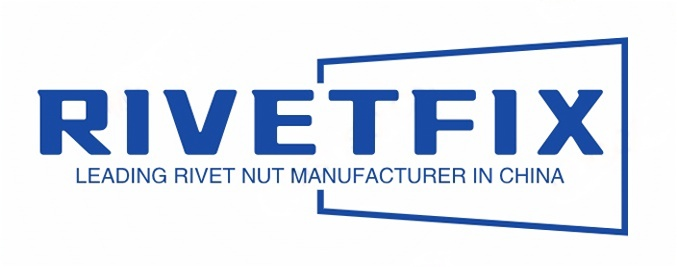
As a leading fastener manufacturer in China with more than 15 years in the industry, Rivetfix are committed to providing first-class quality fasteners and responsive services to the world. We offers a wide range of rivet nuts and clinch nuts designed to meet the unique demands of your projects. Rivetfix ensures you have the right solution for every application. Choose Rivetfix for versatile, cost-effective, and durable fastening solutions tailored to your specific needs. In addition, we can also provide customized rivet nuts service and clinch nuts according to your requirements.
Contact us now for more information and customization options on Rivet Nuts!
Get High Quality Rivet Nuts Quote!
Send Your Rivet Nut Request
For more than 20 years, Rivetfix has helped customers solve many rivet nuts sourcing needs and technical challenges.
Have a question? Contact us and we’ll provide you with the perfect solution.

